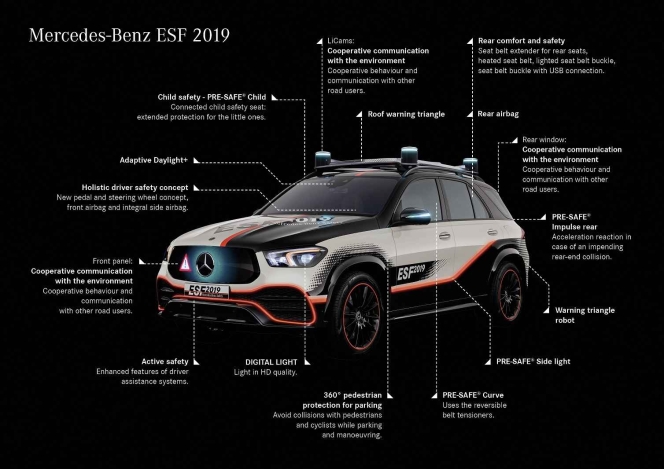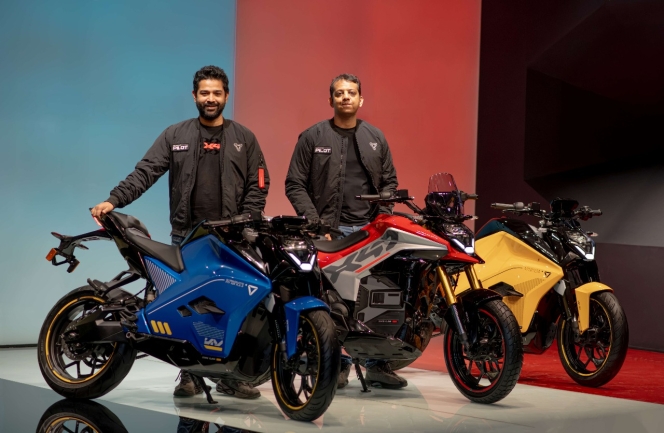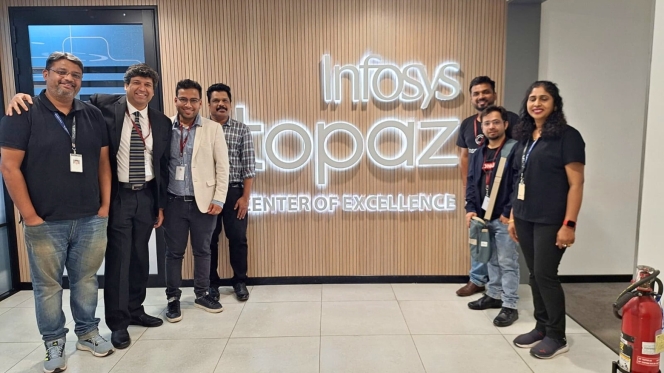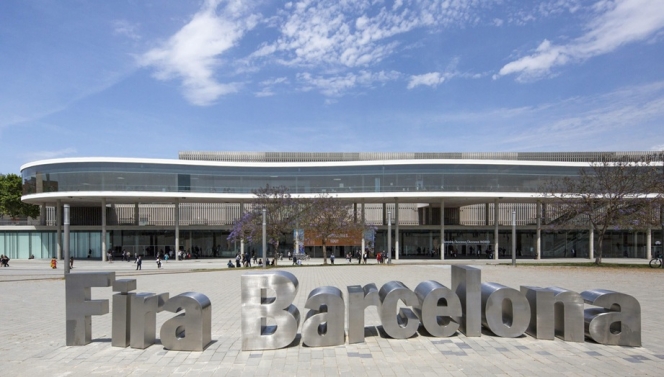Technology Is Not An End But Means To Make Customer Life Easier: Manu Saale
- By 0
- February 04, 2020

Mercedes-Benz R&D India (MBRDI), founded in 1996 in Bengaluru to support Daimler’s research, IT and product development activities, is now one of the largest global R&D centres outside Germany, employing close to 5000 skilled engineers and a valuable centre to all business units and brands of Daimler worldwide. The centre is also a key entity for Daimler’s future mobility solutions through C.A.S.E (Connected, Autonomous, Shared and Electric) for building autonomous and electric vehicles. The centre’s competencies in engineering and IT have progressed to using AI, AR, Big Data Analytics and other modern technologies to provide seamless connectivity. During an interaction with T Murrali, the Managing Director and CEO of MBRDI, Manu Saale, said, “The centre has been growing phenomenally. We have just started a team on cyber security. . . We have been helping to simulate some stack- related solutions using fuel cells. I’m waiting for a clear strategy from the company for a possible venture into the hydrogen path.” Edited excerpts:
Q: You could begin with detailing the contribution of MBRDI to the Experimental Safety Vehicle (ESF)?
Saale: The ESF is a concept vehicle. We have taken a GLE platform and tried to predict technologies that are coming up and put its demo version inside. Some of them are just future technologies but they are strictly based on the data we have collected, and the accident research and digital trends that we have seen.
There is a worldwide safety theme, centred in Germany and India, which is studying all these data and statistics to predict how the future should look like. Mercedes-Benz has a history of building concept cars as mobility is changing around us. This time we have decided to put safety in perspective for the new age mobility with ESF2019. This time we have decided to put safety in perspective for the new age mobility.
For example, in a driverless car there is no steering wheel, so where will you put the air bags as it has been placed in the steering wheel. This means that the airbag concept will have to change. If you go white-boarding on this topic you will realise that some fundamental things you have been counting on all these years will change. This international team in Bengaluru supporting Germany has been working on many of these kind of concepts.
We have brought it here for two reasons. One is for the contribution from India. A lot of digital simulations have been done before implementing the hardware. Bengaluru has contributed to the digital evaluation of the new safety concepts in ESF. The other reason is to inspire the engineers to innovate further based on the first level of fantasies that we have created, and how it could be taken to the next level. These are the kind of things we want our engineers to think about; ESF is a pointer in that direction.
Q: What are the possible changes with the emergence of EVs and autonomous vehicles for safety?
Saale: Imagine not being able to predict the position of passengers when a crash happens. If they are sitting in a conference mode, facing one another other, how can they be protected without an airbag in their front? That’s one; second is the use of different materials within the car and the dynamics that could happen in an accident. Third is connection to the source of a fuel tank / pack, not specific to one place but probably spread across the floor of a car. The battery and its chemical components are also critical in a crash situation.
There are many new things when we think about safety in autonomous and electric vehicles; whereas connectivity plays into our hands. I don’t think the industry has exhaustively thought about what new dimensions can come from driving autonomous vehicles.
Q: What happens if the accident is so severe that all the electrical connections are cut off? Has any thought gone into this?
Saale: I am sure they have thought about it. An airbag can pop up in milliseconds; an SOS is message placed post crash. Today, in an instant, we can ping the world somehow, so information of position, latitude, etc is sent out immediately when an accident takes place. Of course it depends a lot on the emergency services and collision response in the country.
Q: What is the role played by MBRDI in the development of Artificial Intelligence (AI) and Augmented Reality (AR)?
Saale: This is the new age digital; we don’t have to go back to the old world of software alone. Digital has shown new potential in the last few years and we have tried to keep pace with the current trends. AI is certainly one of the buzz words that is coming up.
MBUX, which we flagged off in Bengaluru a few weeks ago, showcases how AI could be used as a technology to make customer life easier in the car. We look at all the use cases to find out what the customer does in a car.
For example, use of camera in a car. During night driving if the driver extends his hand to the vacant seat next to him looking for something, and if it is dark, the camera will sense that he is seeking something and switch on the lights. We need AI for that because we have to understand the hand position and the amount of stretch done; it should not be confused with the driver stretching himself after yawning. Such a simple use case requires a lot of technology. These are things where people look at customer behaviour and say ‘technology is not for the sake of technology but to make customer life easier.’

Q: The Tier-1 companies spread across Germany have come up with many futuristic solutions for vehicles. They have their own research centres. So what is the role of R&D centres of OEMs like this other than integration?
Saale: Every centre has to ride its own destiny. Even if we are a GIC we cannot expect HQ to hold our hand for ever. It’s a typical parent-child relationship and not a customer-supplier one. We have seen all the combinations of GICs working out there in the market. I think we have a good success story here. That is the value-add GIC has to think about.
A survey was done on the value-add from GICs; they used the word entrepreneurship from GICs. It was found that only 6 percent of GICs were entrepreneurial, that were really able to innovate. We were also named in that top 6 percent. It depends on the company culture, relationships, handling discussions with HQ and the local leadership teams. That’s the challenge in a GIC compared to a profit centre that is looking from one customer to another.
Q: You are also in touch with suppliers in India and across the globe for necessary hand-holding?
Saale: Absolutely, imagine a situation where the parents trust the child completely.
Q: You will be the parent and Tier-1s the children?
Saale: No, it is not that way. We behave as Daimler when we talk to Tier-1s. We tell them that ‘you know the car well, so do it by yourself and deliver the product.’ That’s the level of maturity in interaction that one can reach.
Q: When it comes to electronics, OEMs the world over are faced with many regulations. Do you see options for them to comply with all the regulations considering the amount of electronics coming into the car?
Saale: Every new thing is a technical challenge on the table. It can be stricter emission norms or features and functionalities that are difficult to reach, a technical compliance issue that crops up every now and then, and a safety or parking aspect that is covered by many regulations around the world. We thrive on such challenges that have pushed a company like Mercedes to keep on inventing because, among many other things, hardware is getting cheaper and smaller, software capabilities are growing, connectivity is increasing, computing external to the car is possible, and so many other things. OEMs are dealing with authorities, trying to handle what is possible at lower cost, because at the end of the day we have to sell. I am sure that regulators and societies around the world today are looking for some balance between technology and cost.
Q: How do you manage multiple sensors in the vehicle?
Saale: Digital appears to be very complex now but electronics will go through its life cycle and come to a point where man understands its complexity and is able to put it all together. Today, we are talking about sensor fusion - putting together the net of information and seeing it as a whole through various sensors.
Functionalities could range from a switch to radar or lidar with their spectrum of signals, to give various resolutions; the processing capability would be in milliseconds. The more we comprehend the mixed bag of signals we get the better will be our ability to make right decisions.
Q: With all the facilities that you provide to the driver, are you not actually deskilling him?
Saale: The trend is that people don’t want to get into the hassles of driving a vehicle. Driving is stressful and cumbersome to many which is why the autonomous car would gain popularity. The driver has to just punch in where he/she has to go and the vehicle will do it automatically, saving both mental and physical tension. A completely new user base is being introduced into mobility with software features. We have to look at it positively.
Q: Are you also working on cyber security, on things that get into the car?
Saale: We have just started a team now. Our focus on cyber security is at a centre in Tel Avi, Israel.
Q: Do you see scope to improve the thermal efficiency of Internal Combustion (IC) engines further?
Saale: I think the capability, from an engineering perspective, exists to take the IC engine to the next level. The potential continues to be there and all OEMs talk about it. Possibly it is getting affected by the social and environmental aspects.
Q: It is said that the exhaust from a Euro-6 engine is far better than the atmospheric air in many highly polluted cities and it is not actually polluting. What is your opinion?
Saale: It is true. But people say if electricity is generated from coal then aren’t we contributing to pollution? If we localise electric production to one area with everything contained then it would give us better scope to control it rather than spewing it out of every vehicle tail-pipe in all over the world.
Imagine millions of polluting vehicles moving around compared to millions of electric, which don’t have any tail-pipe emissions, with electricity generated by coal that is centralised; it would be a completely different technical and logistic challenge from the environmental point of view. Regulators, politicians and policy makers are all giving their views on this issue; the improvement in living standards and the coming up of smart cities would affect it. I think we are moving in the right direction with the greening of the environment covering everything. I see this sustainable city living much better pictured with electric moving around me.
Q: Can you tell us about the work done around IoT?
Saale: We are working on digitalisation of our production in many ways. One of the teams for Manufacturing Engineering in Bengaluru focuses on digital methods in manufacturing such as production planning, supply chain, logistics and IoT. The team also works on front-loading of production planning.
Q: What is your contribution to the Sprinter F-CELL, the fuel cell application, that replaced the diesel engine?
Saale: We have been helping to simulate some stack- related solutions using fuel cells. I’m waiting for a clear strategy from the company for a possible venture into the hydrogen path. (MT)
Neusoft And MapmyIndia Partner For Intelligent Mobility Solutions
- By MT Bureau
- December 06, 2025

Chinese technology company Neusoft Corporation and Mappls MapmyIndia have signed a Memorandum of Understanding (MoU) to leverage their strengths in software and data resources to collaborate deeply.
The companies will engage in joint technological development, ecosystem collaboration and resource integration to provide navigation products and intelligent mobility solutions tailored to localised needs in emerging markets such as Southeast Asia and India.
The partnership is a response to the fact that while global auto brands are expanding into Southeast Asia and India, they face challenges in these regions due to complex road conditions, unique traffic rules, extensive addressing systems and high localisation adaptation costs. These issues limit the ability of automakers to deliver a complete intelligent user experience.
Under the collaboration, Neusoft will adopt its OneCoreGo Global Intelligent Mobility Solution 6.0 Plus as the core technology carrier, deeply integrating MapmyIndia's map data, real-time traffic information and multi-dimensional value-added services. MapmyIndia is noted as the largest local mapping company in India, holding more than 90 percent market share in in-vehicle navigation.
The integration is intended to strengthen a full capability loop of ‘navigation + payment + interaction + connectivity + operations’.
Through API integration and technological convergence, the two parties will jointly develop navigation products and mobility solutions highly adapted to Southeast Asia, India and similar regional markets. These solutions will deliver precise route planning and real-time traffic guidance, address local user needs and continuously enhance product experience and scenario-based services. This will help automotive partners rapidly launch intelligent vehicle models with competitiveness in local markets.
The partnership enables Neusoft to combine the global end-to-end strengths of its solution with localised ecosystem resources, paving the ‘last mile’ for automakers entering the Southeast Asian and Indian markets and delivering comprehensive intelligent mobility experiences.
- Ultraviolette Automotive
- Zoho Corporation
- Lingotto
- F77
- X-47
- Shockwave
- Tesseract
- Narayan Subramaniam
- Niraj Rajmohan
Ultraviolette Secures $45 Million Growth Capital From Zoho And Lingotto
- By MT Bureau
- December 04, 2025

Bengaluru-based electric vehicle maker Ultraviolette Automotive has secured USD 45 million from Zoho Corporation and Lingotto, one of Europe's investment management companies as part of its ongoing Series E investment round.
The investment from Zoho Corporation was led by Sridhar Vembu, Mani Vembu and Kumar Vembu.
This growth capital will accelerate the domestic and international scale-up of current products F77 and X-47, as well as future product platforms Shockwave and Tesseract.
Ultraviolette has built a design and technology-led enterprise with the F77 and the recently launched X-47.
The company has expanded to 30 cities across India in a short span of 12 months and is expanding to 100 cities by mid-2026. The F77 motorcycles were recently launched in the United Kingdom, bringing Ultraviolette's presence to 12 countries across Europe.
Narayan Subramaniam, Co-Founder & CEO, Ultraviolette Automotive, said, “We are glad to announce our Series E investment from Zoho and Lingotto. Lingotto's legacy of backing iconic performance and mobility brands, combined with Zoho's long-term commitment to fostering cutting-edge Indian innovation, aligns perfectly with Ultraviolette's mission to build category-defining electric mobility solutions for India and global markets.”
Niraj Rajmohan, CTO & Co-Founder, Ultraviolette, said, "With the ongoing Series E investments, we are doubling down on growth and expanding our production to meet increasing demand. Our focus is on advancing breakthrough battery technology, elevating performance capabilities and expanding production to support upcoming product platforms. This investment will accelerate our journey towards scaling into India and global markets."
Disseqt AI Partners Tata Technologies And Infosys For Agentic AI Adoption
- By MT Bureau
- December 04, 2025

Agentic AI platform Disseqt AI has announced a partnership with Tata Technologies and Infosys. As per the agreement, Disseqt AI will assist both companies' IT and DevOps teams in developing and fast-tracking the production of tailored Agentic AI applications for automobile and FinTech companies globally.
The partnership aims to help auto and FinTech firms embrace customised Agentic AI faster and in a secure manner.
Disseqt AI, which has operations in Bengaluru, San Francisco and Dublin, provides an enterprise-grade platform for IT and DevOps teams. The company claims its platform cuts down Agentic AI testing and operations cost by 70 percent and improves productivity by up to 80 percent. The platform allows these teams to test, simulate and monitor their Agentic AI systems tailored across industries, ultimately enabling enterprises to operationalise tailored Agentic AI faster and at scale, without sacrificing ethics, governance and compliance.
Apoorva Kumar, Founder and CEO, Disseqt AI, said, “This is a landmark announcement for us as we further embed Disseqt into enterprise workflows for testing, simulation, monitoring and auditability purposes. We are already working closely with both Tata and Infosys on several projects and are proud to be part of their innovation initiatives”
Last month, Disseqt AI announced a strategic collaboration with HCLTech and Microsoft to guide financial services institutions with Agentic AI adoption.
Battery Passport Implementation Beyond EVs To Be Focus Of Barcelona Event
- By MT Bureau
- December 03, 2025

Battery and Energy Storage Europe has announced a programme focused on the EU Battery Passport, a regulatory milestone that becomes mandatory in February 2027. The Barcelona-based event will address the compliance gap for applications beyond the electric vehicle (EV) sector, which have dominated the conversation to date.
The event, taking place on 8th and 9th September 2026 at Fira de Barcelona's Gran Via venue, will focus on solutions and talks for applications that fall within the regulation's scope: stationary energy storage, industrial batteries, grid-scale systems, long-duration energy storage and emerging applications in aerospace, maritime and rail electrification.
With the February 2027 legal requirement date approaching, the programme will bring together industry leaders, technology providers, and policy experts to address the compliance challenges facing these diverse sectors.
The Battery Passport is a digital record documenting a battery's entire lifecycle, from raw material sourcing to production, performance and eventual recycling. From February 2027, it becomes mandatory for all rechargeable EV, industrial and LMT batteries over 2 kWh sold in the EU.
Linked via QR code, the passport will track each battery's complete lifecycle, including composition, carbon footprint and recycled content, fundamentally transforming supply chain transparency and sustainability practices across Europe.
The programme will explore implementation topics including digital infrastructure requirements, data management systems, supply chain integration, verification processes and recycling traceability.
Ken Davies, Conference Programme Director at Battery and Energy Storage Europe, said, "The Battery Passport represents one of the most significant regulatory shifts our industry has faced, yet many companies are still grappling with what implementation actually means for their operations. While the EV sector has dominated the conversation, there's a critical need to address how this regulation applies to stationary storage, industrial applications and the innovative battery technologies powering Europe's energy transition. With the clock ticking toward February 2027, Battery and Energy Storage Europe will shine a light on the practical implementation requirements for these often-overlooked sectors, connecting stakeholders with actionable solutions and bringing together the expertise, technology providers, and collaborative spirit needed to turn compliance into competitive advantage across the full spectrum of battery applications."





Comments (0)
ADD COMMENT